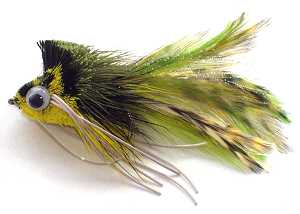Diving Olive and Yellow Bass Bug
This buoyant deer hair bass bug fly pattern makes a diving motion when it is retrieved through the water surface because of the sharp 90 degree angle cut into the top of the fly's head. It makes a disturbance that attracts nearby smallmouth, largemouth and black bass.

DEERHAIR BASS BUG FLY PATTERNS. Hook size 6 - $US each
Larry Dahlberg’s Diving Bass bug has become the standard design for diving deerhair flies. It is ideal for situations when the bass are not aggressive enough to chase a popper pattern. Tim England from Colorado has developed the standard pattern. He has made the diving feature even more effective during the retrieve by modifying the angle the deer hair is cut above the head. The fly Tim made was called Ty’s Tantilizer. The design maintains a better upright position in the water. When you strip the fly hard, water surges over the nose and piles up against the ridged collar, forcing the fly into an abrupt dive. A deerhair diver actually creates more sound than a popper as it penetrates the water surface. The wide deerhair collar catches air bubbles and makes this pattern look more substantial under water. The bubbles also creates additional sparkle when the sun is out and reflects of their surface. When stripped forcefully a diving bug makes a long trail of bubbles giving the bass something to home in on. Some fly tiers use rabbit fur strips for tails. It works well and is quicker to tie than using feathers but it has the disadvantage of becoming waterlogged and deceasing the diving bass bug’s buoyancy. It also makes casting heavier and laborious. We prefer to use feathers for our tails as they shake relatively dry normally on the first false cast. They are also a lot easier to cast when wet. I hope you like our version of a Diving bass bug which is a mixture of the best design features of Larry Dahlberg’s Diving Bass Bug and Tim England's Ty’s Tantilizer
Accuracy and presentation are the keys to getting Bass to strike. I like to cast a diving bass bug to likely bass lurking areas where the fish lie in wait for food to come close. Lily pads or drop off areas with submerged weed beds are ideal palaces. I let the bass bug sit for a while after it lands. I then make one long strip with the rod tip pointed at the water. The fly dives under the water and pops back up to the water surface. I normally wait until the water calms and then strip again. I experiment with the speed of the retrieve. If the Bass are not surface feeding because of the water temperature I am always prepared to change tactics to sub-surface patterns like Clouser’s Minnow, Matukas, Muddlers, Zonkers or Woolly buggers
If you want to use surface bass bug flies use them near the over hanging vegetation near the shore line. Night bass bugging is slightly different to daytime. Let the bug land with a loud plop. On the forward cast stop the line suddenly. Use a slow but steady retrieve to try and imitate a land animal that has accidentally fallen in and is trying to swim to safety. Round faced deer hair flies and drivers are ideal. Do not use poppers as they are too noisy. Mice bass bugs are very successful at night.
Customer's Comment
It is getting hot and for most of the summer bass will be found suspended in relation to structure and cover. Logjams and brush-piles can be found in almost every lake and reservoir in North America. If you can locate one near a creek channel the bass fishing can become as hot as the summer is. Your Olive and Yellow Diving bass bug I have found to be very productive when used to probe log jams and brush piles. Clive Karas
Customer's Comment
I have been absolutely killing the bass with your bugs. Strip pause. It is still water. Sometimes they attack it on the move but other times I see them approach and I just let it sit. They will regard it for 10-30 seconds and then just slurp it. The beauty of these bugs is they withstand pretty careful scrutiny and still look like something good to eat! Will Jennings, CA, USA


Bass Bug books

